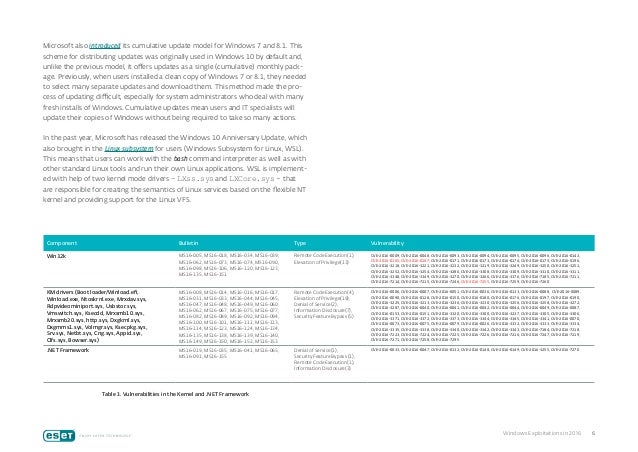Rootkit Ntoskrnl Executive Summary
Blue Screen Ntoskrnl ExeBlue Screen Ntoskrnl Exe This particular type of software is programmed specially for the intent behind scanning your entire registry. After that, it could generate% increase of fundamental number of errors and bad entries in your components. The cleaner software will also categorize the errors their own respective. Blue Screen Ntoskrnl Exe Don't step blindly in a very gym and initiate playing around with some weights or start trying every machine you uncover. Save a complete lot of your energy and skip the time and experience.

Summary: This security update resolves three privately reported vulnerabilities in all supported releases of Microsoft Windows. The vulnerabilities could allow elevation of privilege if an attacker logs on to the system and runs a specially crafted application. AVG found Hidden Rootkits - posted in Am I infected? Ntoskrnl.exe, ACPI.sys, fltmgr.sys, Ntfs.sys, tcpip.sys, and win32k.sys. Etc) be aware that they use rootkit-like techniques techniques.
Blue Screen Ntoskrnl Exe If unfortunately, your computer problems are coming out of the RAM, will probably have in order to the faulty RAM walking cane. You can also test your overall RAM stick by changing it with another working one, and if the blue screen error returns.
If the error still persists, always be mean presently there is easy with the RAM stick, and the other way round.
BKS06 Pendekar Bongkok 07.  BKS04 Mutiara Hitam 05. BKS07 Pendekar Siluman 08. BKS03 Cinta Bernoda Darah 04. BKS05 Istana Pulau Es 06.
BKS04 Mutiara Hitam 05. BKS07 Pendekar Siluman 08. BKS03 Cinta Bernoda Darah 04. BKS05 Istana Pulau Es 06.
• • • A rootkit is a collection of, typically, designed to enable access to a computer or areas of its software that is not otherwise allowed (for example, to an unauthorized user) and often masks its existence or the existence of other software. The term rootkit is a of ' (the traditional name of the privileged account on operating systems) and the word 'kit' (which refers to the software components that implement the tool). The term 'rootkit' has negative connotations through its association with. Rootkit installation can be automated, or an can install it after having obtained root or Administrator access. Obtaining this access is a result of direct attack on a system, i.e. Exploiting a known vulnerability (such as ) or a (obtained by or tactics like ').
Once installed, it becomes possible to hide the intrusion as well as to maintain privileged access. The key is the root or administrator access. Full control over a system means that existing software can be modified, including software that might otherwise be used to detect or circumvent it. Rootkit detection is difficult because a rootkit may be able to subvert the software that is intended to find it. Detection methods include using an alternative and trusted, behavioral-based methods, signature scanning, difference scanning, and analysis.
Php and mysql web development pdf torrent. Removal can be complicated or practically impossible, especially in cases where the rootkit resides in the; reinstallation of the operating system may be the only available solution to the problem. When dealing with rootkits, removal may require replacement, or specialized equipment. Contents • • • • • • • • • • • • • • • • • • • • • • • • • History [ ] The term rootkit or root kit originally referred to a maliciously modified set of administrative tools for a that granted ' access.

If an intruder could replace the standard administrative tools on a system with a rootkit, the intruder could obtain root access over the system whilst simultaneously concealing these activities from the legitimate. These first-generation rootkits were trivial to detect by using tools such as that had not been compromised to access the same information. Lane Davis and Steven Dake wrote the earliest known rootkit in 1990 for ' UNIX operating system. In the lecture he gave upon receiving the in 1983, of, one of the creators of, theorized about subverting the in a Unix distribution and discussed the exploit. The modified compiler would detect attempts to compile the Unix login command and generate altered code that would accept not only the user's correct password, but an additional ' password known to the attacker.
Additionally, the compiler would detect attempts to compile a new version of the compiler, and would insert the same exploits into the new compiler. A review of the source code for the login command or the updated compiler would not reveal any malicious code. This exploit was equivalent to a rootkit. The first documented to target the, discovered in 1986, used techniques to hide itself: the intercepted attempts to read the, and redirected these to elsewhere on the disk, where a copy of the original boot sector was kept.
Over time, -virus cloaking methods became more sophisticated, with advanced techniques including the of low-level disk BIOS calls to hide unauthorized modifications to files. The first malicious rootkit for the operating system appeared in 1999: a trojan called NTRootkit created. It was followed by HackerDefender in 2003.
The first rootkit targeting appeared in 2009, while the worm was the first to target (PLC). Sony BMG copy protection rootkit scandal [ ].